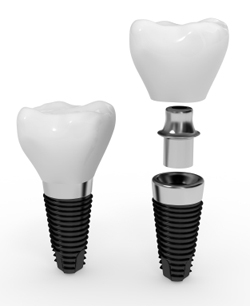Dental Implants

About Dental Implants
Dental implants have revolutionized prosthodontics and the way a missing tooth or teeth can be replaced. They are the gold standard for the replacement of teeth because dental implants allow a missing tooth or teeth to be restored to optimum function and appearance.
A dental implant is a titanium cylindrical root shaped fixture, which is placed in the upper or lower jaw bone for later attachment. The implant attachment can be a tooth shaped connector (abutment) that can be used to replace a single tooth or multiple teeth. Implant attachments can also act like snaps on clothing and be used for attaching what would be a loose denture or partial denture and creates a “snap-on” denture or partial denture. Dental implants also help to preserve the jaw bone and retard the shrinking of the jaw that is commonly seen in the area of missing teeth or in long-term denture wearers.
If you have a missing tooth, teeth, or a poor fitting denture or partial, then implants may be for you.
In the past a missing single tooth would often receive a fixed bridge, where the teeth on either side of the missing tooth are prepared for crowns and a false tooth is connected between them. Today, the ideal treatment is a crown supported by a dental implant, avoiding any damage to the other teeth. Dental implants are the ultimate solution for people with congenitally missing teeth.
Dental implants can also replace multiple missing teeth that might otherwise be replaced by a fixed bridge or a removable partial denture. Dental implants can support a fixed bridge to replace the teeth, making a removable partial denture unnecessary.
In some cases too many teeth are missing to use a fixed bridge. Using dental implants with attachments that snap into a removable denture or partial denture, however, will greatly improve the denture’s stability and retention and improve the patient’s chewing function. Depending on the number of dental implants used, a denture can be made that clips onto the dental implants, or even a non-removable ‘hybrid’ denture that can remain in the mouth. Stability of the dentures is improved with the use of only two dental implants with attachments, but greater satisfaction is achieved as the number of dental implants is increased.
Implants work by acting like the roots of natural teeth. They are placed in the bone, and become integrated into the bone by a process called osseo-integration. If you are healthy, and have healthy bone and healthy gum tissue, you may be a good candidate for dental implants.
What To Expect
The initial cost of dental implants may seem greater than other treatments, such as traditional dentures, partials, or bridges. However, consider important factors before making a decision regarding the relative long-term cost of dental implant treatment. Dental implants can be placed without harming any of the adjacent teeth. For example, a bridge requires preparing the teeth on each side of a missing tooth. This process is irreversible. Dental implants provide support similar to that of a natural tooth’s root. It has been shown that dental implants cause fewer dental treatment needs in the long run. Taking all the costs and benefits into consideration, dental implants are often less expensive than other methods of tooth replacements.
If you are missing teeth, and are a candidate for dental implants, you can benefit from increased chewing efficiency, improved appearance and speech. Dental implants can be a solution if it is difficult for you to wear a denture or a partial because of pain and discomfort due to the lack of stability.